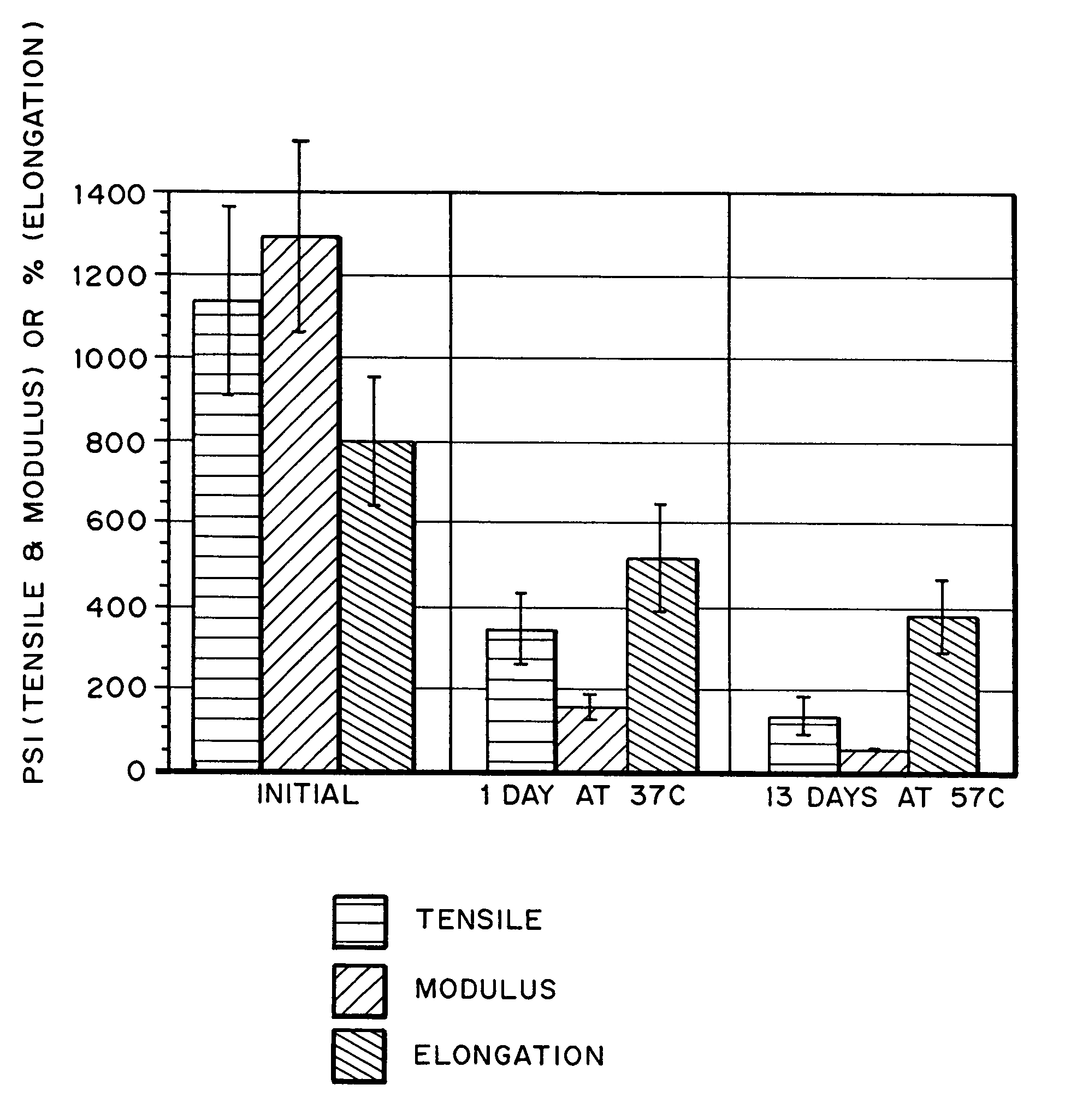Hydrogels for orthopedic repair
a technology for orthopedic repair and gels, applied in the field of disease treatment, can solve the problems of difficult repair of injuries, low use of gels, and high mechanical stress, and achieve the effects of reducing the water absorption capacity of gels, reducing the risk of fracture, and high biocompatibility
- Summary
- Abstract
- Description
- Claims
- Application Information
AI Technical Summary
Benefits of technology
Problems solved by technology
Method used
Image
Examples
example 1
Preparation of PEG-TMC-Diacrylate / DAA Hydrogel
[0075]A macromer consisting of a 35 kiloDalton (kDa) core (manufacturer-specified molecular weight; MW about 27 kDa by GPC) of polyethylene glycol (PEG) is reacted with trimethylene carbonate, giving hydroxy-terminated molecules with an average of about two PEG segments and about 15 TMC groups per molecule. This molecule is then end-capped with acryloyl chloride to make it crosslinkable. The molecule is called 35KTA2. Details of synthesis are described in WO 98 / 12243 by Focal.
[0076]A solution was prepared in water which contained by weight about 68% DAA, 15% 35KTA2, about 17% water, and materials for redox-assisted photopolymerization, including Irgacure® 651 (2,2-dimethoxy 2-phenyl acetophenone; DMAP), t-butyl hydroperoxide, and triethylamine as electron carrier and buffer. This was accomplished by adding 3.0 g of 35kTA2 and 13.6 g of DAA to 3.4 g of water, and heating to 70° C. with stirring to complete dissolution. Then 83 microliters...
examples 2 – 27
Examples 2–27
Synthesis and Comparison of DAA and Other Vinyl-Based Hydrogel Materials
[0082]Additional samples of potentially suitable materials were prepared and subjected to a limited set of tests. These samples are shown in Table 2.
[0083]
TABLE 2DAA and Other Vinyl-Based HydrogelsExam-VinylPhysicalPhysical%%pleMonomers2Macromer(s)%1CharacteristicsCharacteristicsH2OSolidsClamp5No.(%)1(%)1H2OAs Formed4After HydrationUptakeat Equil.testAdherence6, Notes2DAA (4.4)35KTA260.6Soft, elasticVery soft, elastic3626.36PassCohesive(20.0)(swollen)Failure20KTA2 (5.0)Artic. Cartil.3DAA (60.0)None40.0Rigid, opaque,Rigid, opaque,~0~60.0——plastic (yielded)plastic4DAA (49.1)35KTA232.7Tough, opaque,Flexible, opaque,13928.1Cohes. Fail. Patella(18.2)resilientresilient5DAA (54.0)3.3KL5 (10.0)36.0Strong, brittleBrittle9333.26DAA (41.0)35KTA227.2——17626.3——VOE (21.6)(10.0) 7DAA (51.0)35KTA234.0Tough, notchTough, opaque,135———(15.0)resistantflexible8DAA (68.0)35KTA217.0Stiff, opaque,Somewhat tough,101———(15....
example 28
Hydrogels Based on Polyurethane-Based Macromers
[0105]The reaction of PEG or poloxamer diols and, optionally short-chain diols with diisocyanates, produces macromeric diols which can be reacted with acryloyl chloride, optionally after reaction to provide degradable linkages, to provide acrylic-functional macromonomers with a wide range of properties from soft and weak to quite tough. These versatile compositions allow control of solubility and hydrophobicity.
[0106]A macromer with a polyurethane backbone, used in Examples 10 and 11 above, was prepared by reacting 1,4-butanediol (1.27 g, 0.0147 m), PET, MW 3,400 (50.00 g, 0.0147 m) and 1,6-diisocyanatohexane (4.66 g, 0.0277 m) in toluene with dibutyltin dilaurate catalyst (80° C., 4 hr.). The resulting macrodiol was acrylated with acryloyl chloride and isolated by precipitation with hexane. This material was used in an adhesive / sealant formulation, shown in Example 10, by mixing it (3.0 g) into a solution of DAA (3.0 g) in water (4.0 g...
PUM
 Login to View More
Login to View More Abstract
Description
Claims
Application Information
 Login to View More
Login to View More - R&D
- Intellectual Property
- Life Sciences
- Materials
- Tech Scout
- Unparalleled Data Quality
- Higher Quality Content
- 60% Fewer Hallucinations
Browse by: Latest US Patents, China's latest patents, Technical Efficacy Thesaurus, Application Domain, Technology Topic, Popular Technical Reports.
© 2025 PatSnap. All rights reserved.Legal|Privacy policy|Modern Slavery Act Transparency Statement|Sitemap|About US| Contact US: help@patsnap.com


